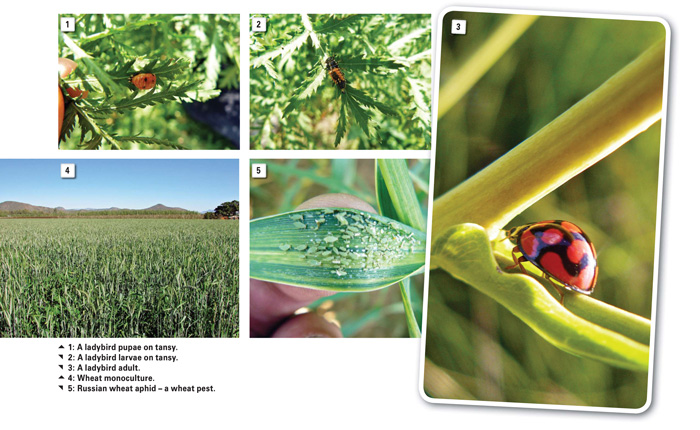October 2017
Many producers want sustainable crop production systems that will reduce input costs of chemical fertilisers and pesticides, and make the whole system more resilient during times of environmental fluctuations such as periods of drought.
Intercropping your grain crops might help you to achieve this goal. Intercropping is the cultivation of two or more plant species in the same field at the same time. This includes the use of insectary plants, border crops, cover crops, and water reservoirs. These can be established perennial plants into which an annual row crop can be seeded.
Intercropping is an ecological approach or tool that can be combined with other strategies. There are many different approaches and strategies. A good idea is to start with a simple intercropping plan, such as including strips of a cover crop within the cash crop, based on the producer’s observation that a flowering cover crop attracts beneficial insects.
The producer may later add other elements such as perennial border crops of herbs and flowers that repel pest insects and provide beneficial habitats to support natural enemies of the farm’s major pest insects. In this way, the agricultural cropping system can gradually be turned into a more diverse system.
The choice of plants for intercropping will depend on the specific system, the geographical area and the insects occurring in these
areas. A good plant to choose would be a hardy perennial that is drought tolerant, will attract beneficial insects and repel pest insects, have a deep root system that can accumulate potassium, phosphorus, and copper from the subsoil and can be used as a living mulch and cover crop in dry areas. The plant should be adapted and grow well in the specific area.
Ideal intercrop plants will provide food and shelter for all life stages of beneficial organisms, suppress weeds, and grow in close proximity to the cash crop without competing for space, light, water and nutrients. The cover crop and cereal should occupy different above and below-ground niches and should complement each other, increasing the cropping system’s ability to capture and use resources, such as sunlight, water and soil nutrients, efficiently.
Legumes, clovers and many herb species such as yarrow, fennel, tansy, catnip and African wormwood fit these criteria. In planning an intercropped system, it is important to identify specific plants and management practices that best support populations of beneficial organisms. This will require some information gathering and management skill on the part of the producer, but this investment will result in many benefits.

The benefits of intercropping include:
Natural ecosystems are complicated systems with ecosystem functions performed by many interrelated organisms in the system. What affects one organism in this system will affect all the other organisms. Agricultural systems where crops are planted in a monoculture, on the other hand, are simple systems where most of the components that provide ecosystem functions have been removed from the system.
This is particularly evident during climatic changes. When it rains after a drought, pest insects often become a problem in agricultural systems, because the insects that keep the pest insects under the damage threshold are missing in agricultural systems. Many insect species are able to survive adverse conditions and are very adaptable to changes. This enables them to increase their populations when conditions become suitable. Insects are, however, not only pests on agricultural crops, but in natural systems also perform many valuable ecosystem functions. The insect assemblages in intercropped wheat systems are more diverse because of an increased crop diversity.
Insects included in this system perform diverse ecosystem functions such as managing pest insects under the damage threshold,
pollination, bioturbation and fertilisation of the soil. These services provided by insects can be utilised in agricultural systems by changing and diversifying the agricultural environment through intercropping.
These systems will have an advantage over conventional wheat systems because the diversity in intercropped wheat ecosystems will enable the system to adjust to adverse conditions and become more resilient and sustainable. This will result in more effective wheat cultivation because sustainability equals profitability.
Economic sustainability of a producer will increase by decreasing the need for expensive inputs, such as nitrogen fertiliser and pesticides.
Producers with any queries can contact Dr Astrid Jankielsohn at 058 307 3431, 082 564 3795 or jankielsohna@arc.agric.za.
Publication: October 2017
Section: Focus on